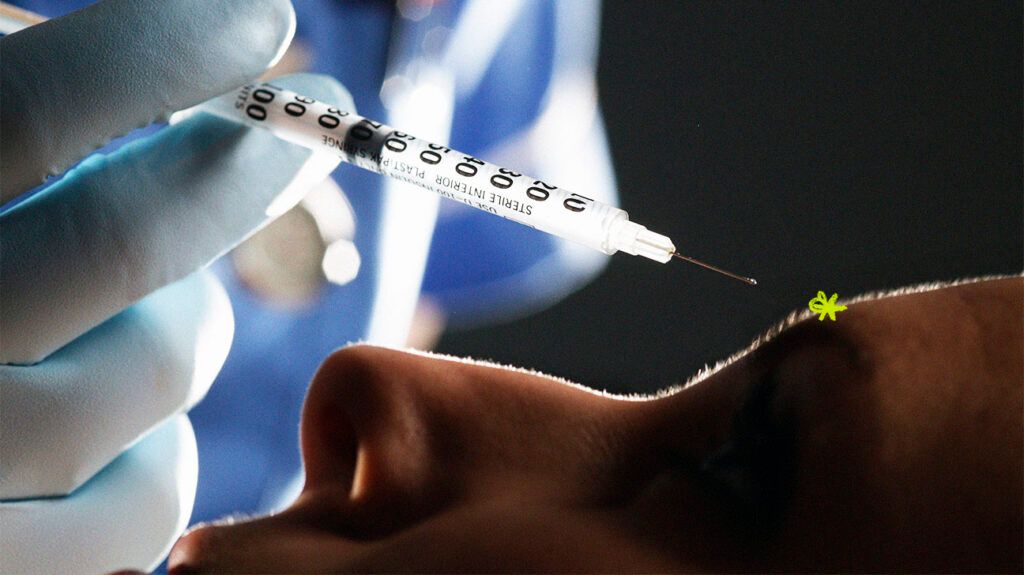While the Food and Drug Administration (FDA) hasn’t approved Botox for trigeminal neuralgia, doctors may prescribe the drug off-label for this use. Several studies have looked into the effectiveness and safety of Botox for trigeminal neuralgia.
Trigeminal neuralgia is a type of long-term (chronic) pain condition that affects your trigeminal nerve. This nerve provides feelings and sensations to parts of your head and face.
If you have trigeminal neuralgia, you experience sudden episodes of severe facial pain. These episodes may have several triggers. They may last a few seconds or minutes and can happen several times a day. There are several treatments doctors may use to treat trigeminal neuralgia, including medication.
Although the FDA hasn’t yet approved Botox for trigeminal neuralgia, it may be a safe and effective treatment. Doctors can prescribe Botox off-label for this use. Scientists have carried out several studies into how well the drug reduces pain from trigeminal neuralgia.
This article discusses how Botox can be used for trigeminal neuralgia, where Botox is injected, and its side effects. It also answers some frequently asked questions (FAQ) about Botox and trigeminal neuralgia.

Doctors may use Botox to
Off-label medication use can be safe and effective. However, it may also
- lack of strong medical evidence about the drug being used for the condition
- unique or unknown side effects
- limited information about how well the medication works for the condition
Your healthcare professional will discuss the potential benefits and risks with you. However, Botox injection is generally considered a safe and
Study information
Scientists have conducted several studies into Botox for trigeminal neuralgia.
In one
Other clinical trials also found that Botox is an effective treatment for trigeminal neuralgia. In several studies, the frequency and intensity of trigeminal neuralgia pain was reduced by
Healthcare professionals may
A 2022 case report found that injecting Botox into your trigeminal ganglion is effective for trigeminal neuralgia pain. Your trigeminal ganglion is part of your nervous system. It sits under your skin, on the side of your face between your ear and cheek.
That same 2022 case report indicates that Botox injections into the mental foramen may provide long-lasting trigeminal neuralgia pain relief. Your mental foramen is part of your nervous system that sits inside your lower jaw.
Botox may cause certain side effects, some of which are more common than others. It’s important to note that the side effects reported in Botox’s clinical trials were from when the drug was being used for FDA-approved uses.
Some more common side effects of Botox in clinical trials may include:
- pain or tenderness at the injection site
- muscle weakness
- flu-like symptoms
- headaches
- an upset stomach
- temporary drooping eyelids, if you received the injection in your face
These side effects may be temporary, lasting a few days to weeks. However, if the side effects last longer than that, bother you, or become severe, be sure to talk with your doctor or pharmacist.
Boxed warning
Botox has a boxed warning about the risk of spread of toxin effects. This is the most serious warning from the FDA.
In some situations, Botox’s effects may spread away from the site where the drug is injected. This can cause a serious condition called botulism, which may lead to symptoms such as difficulty swallowing, double vision, and muscle weakness all over the body.
Some of the symptoms may be life threatening. Talk with your doctor if you’re experiencing any symptoms after your Botox injection. If your symptoms feel life threatening, call 911 or your local emergency number.
ALLERGIC REACTIONFor some people, Botox can cause an allergic reaction.
In general, symptoms of allergic reaction can be mild or serious. You can learn more about possible symptoms in this article.
Ways to manage
For mild allergic reaction symptoms, such as a mild rash, call your doctor right away. They may recommend treatments to help manage your symptoms. They’ll also let you know whether you should keep taking the medication.
For severe allergic reaction symptoms, such as swelling or trouble breathing, call 911 or your local emergency number right away. These symptoms require immediate medical care because they can become life threatening. If you’ve had a serious allergic reaction to Botox, your doctor may recommend taking a different medication instead.
Some FAQ about Botox for trigeminal neuralgia include:
Can Botox make trigeminal neuralgia worse?
No, research
However, Botox is an off-label treatment for trigeminal neuralgia. This means the FDA has not yet approved Botox for trigeminal neuralgia treatment. And the safety and effectiveness for this use have not been reported in the drug’s clinical trials.
If you have concerns about worsening trigeminal neuralgia while receiving Botox, talk with your doctor.
Does insurance cover Botox when it is used for trigeminal neuralgia?
It’s possible. Your insurance may cover Botox when prescribed to treat trigeminal neuralgia. However, as with all medications, the cost of Botox can vary. Factors that may affect the price you’ll pay include:
- your treatment plan
- your insurance coverage
- the cost of the visit to your doctor to receive doses of Botox
To find out what the cost of Botox will be for you, talk with your doctor or insurance provider.
Doctors may prescribe Botox off-label for treatment of trigeminal neuralgia. Although the FDA has not yet approved it for this use, many studies have found it is safe and effective. Botox injections may help significantly lower trigeminal neuralgia pain for up to several months.
Healthcare professionals usually inject Botox into your facial trigger zones to help relieve trigeminal neuralgia pain. These zones may vary from person to person.
If you have questions about Botox and trigeminal neuralgia, talk with your doctor or pharmacist.
